![]() Fresh News:
Fresh News:
Invitation to Prague – Stamps with Prague Motifs
Prague, a city spreading out on both banks of the Vltava River, is undisputedly one of the most picturesque metropolises in Europe. Prague was the historical seat of the Czech rulers, an important commercial crossroads and a center of education, science and the arts. It is a place where over the centuries various cultural echelons have overlapped and taken hold and where artistic styles and directions and currents of thought have crossed paths. Unlike many other historical cities around the world, Prague has maintained an entire historical district – the Old Town with its narrow, medieval streets, monumental structures of the high gothic era, renaissance and baroque palaces with gardens, cathedrals and churches. All of this bears witness to the fact that this city in the middle of Europe is an architectural and historical treasure that can be discovered again and again. Prague inspired many artists also in the twentieth century. Here one can find unique works of the art nouveau, cubism, functionalism and the most modern architecture of the new millennium.
Prague, as a city with a rich historical and cultural tradition, remains an inexhaustible subject of study for leading creative artists – the creators of postage stamps.
Issues dedicated to Prague Castle, to cultural monuments registered on the UNECSO list or artworks from the collection of the National Gallery are also usually printed using the unique multi-color die stamping technology from flat disks, and they document the high level of artistic quality of our stamp creations, on which important Czech artists, engravers and commercial artists participate.
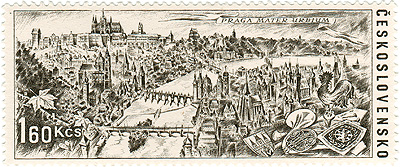 The Latin phrase PRAGA MATER URBIUM appears at the top of a Czechoslovak postage stamp from 1967. This perfect monochromatic engraving by the doyen of the Czech school of engraving, the master Bedřich Housa, represents a view of the historical city center in the valley of the Vltava River and an unmistakable panorama of Hradcany – Prague Castle and the Cathedral of St. Vitus.
The Latin phrase PRAGA MATER URBIUM appears at the top of a Czechoslovak postage stamp from 1967. This perfect monochromatic engraving by the doyen of the Czech school of engraving, the master Bedřich Housa, represents a view of the historical city center in the valley of the Vltava River and an unmistakable panorama of Hradcany – Prague Castle and the Cathedral of St. Vitus.
From the opposite bank of the river, there is a depiction of the Old Town of Prague with Charles 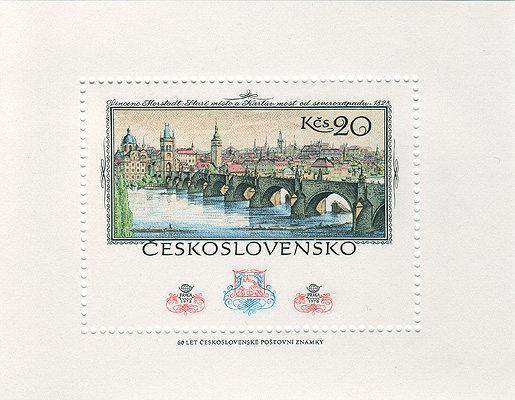 Bridge in the front on a veduta by Vincenc Morstadt, a 19th century draftsman and engraver. His colored drawing from 1828 was rendered as an engraved stamp by another of the outstanding Czech engravers, Miloš Ondráček. That Czechoslovak postage stamp was issued on the occasion of the PRAGA 1978 World Exhibition, and later it was awarded Briefmarkenwelt magazine as the world’s most beautiful stamp of 1978.
Bridge in the front on a veduta by Vincenc Morstadt, a 19th century draftsman and engraver. His colored drawing from 1828 was rendered as an engraved stamp by another of the outstanding Czech engravers, Miloš Ondráček. That Czechoslovak postage stamp was issued on the occasion of the PRAGA 1978 World Exhibition, and later it was awarded Briefmarkenwelt magazine as the world’s most beautiful stamp of 1978.
The issue Artworks on Stamps started being released in Czechoslovakia in 1966. Since then, series of three to five stamps have been issued regularly, creating a sort of pinnacle of the stamp production in this country each year. The Czech Republic has followed up on this tradition. Since 1993, these issues have presented not only the paintings of old Czech masters or of important European painters, but also the works of modern artists of Europe and of our provenience. Through postage stamps, collectors from around the world can become familiar with pictures that are found mostly in permanent exhibits of the National Gallery in Prague. As an example, we will name one of the most famous works from the world of painting – The Feast of the Rose Garlands by Albrecht Dürer (1471-1528). The painting was made in 1506 during Dürer’s second stay in Venice as an altarpiece for the Church of St. Bartholomew. A hundred years later, the art-loving Emperor Rudolph II acquired it for his collection, making Prague at the turn of the 16th and 17th centuries not only the seat of the Hapsburg monarchy, but also a center of science and the arts. It is interesting that The Feast of the Rose Garlands has been issued on Czechoslovak postage stamps three times in masterful renderings by leading Czech engravers. In 1968 it was first engraved by Jiří Švengsbír, in 1971 Ladislav Jirka selected a detail from the picture (with a self portrait of Dürer), and The Feast of the Rose Garlands was issued for the third time as a block in 1989. That issue allowed the author of the engraved rendering, Miloš Ondráček, to work creatively with the model as a whole, since the upper, pictorial part of the block is a faithful rendering of Dürer’s work in its entirety (in the lower part of the block there are two stamps, the first showing in detail the seated Madonna and child, and the second showing an angel playing on the lute).
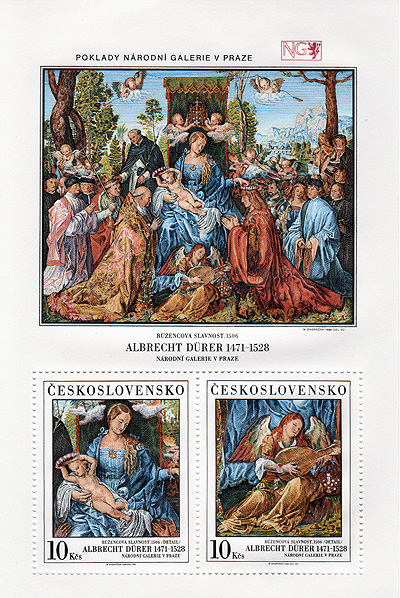
A counterpoint to Dürer’s picture might be a transcription of the work of a major representative of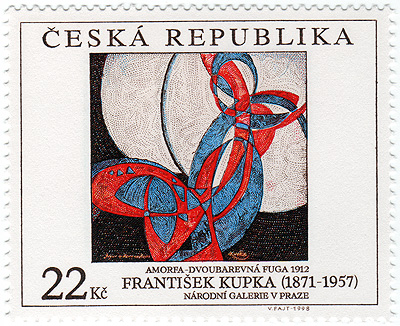 modern art of the 20th century, a pioneer of abstract painting by the Czech painter and illustrator František Kupka (1871-1957), whose canvasses are found in the collections of the world’s leading art galleries. Amorpha: Fugue in Two Colors, one of Kupka’s most famous paintings, was issued on a Czech Republic postage stamp in a noteworthy engraving transposition by the artist and engraver Václav Fajt on the occasion of the holding of the PRAGA 1998 International Exhibition.
modern art of the 20th century, a pioneer of abstract painting by the Czech painter and illustrator František Kupka (1871-1957), whose canvasses are found in the collections of the world’s leading art galleries. Amorpha: Fugue in Two Colors, one of Kupka’s most famous paintings, was issued on a Czech Republic postage stamp in a noteworthy engraving transposition by the artist and engraver Václav Fajt on the occasion of the holding of the PRAGA 1998 International Exhibition.
Stamps based on Prague monuments, architectural splendors, famous buildings or artworks found in the capital of our country have been among the most beautiful stamps of Czechoslovakia (until 1992) and the independent Czech Republic (since 1993) and have earned many awards at home and abroad.
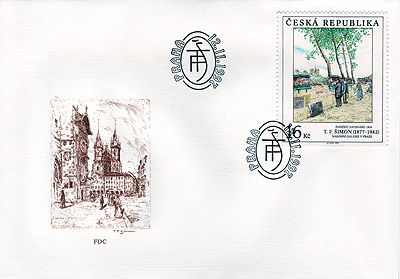
Postage stamps are thus becoming an eloquent, beautiful invitation to Prague, the capital of the Czech Republic, a city in the heart of Europe that enchants millions of foreign visitors each year.
|
|
|
|
|
